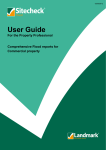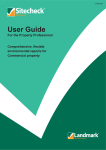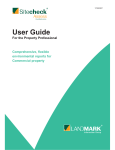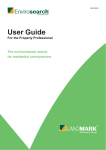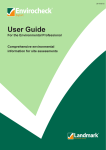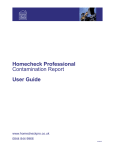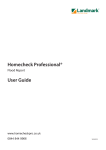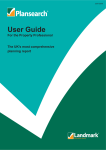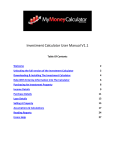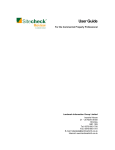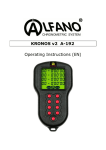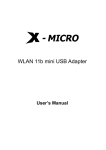Download User Guide - Landmark Legal Reports
Transcript
29/07/2009 User Guide For the Property Professional Comprehensive Flood reports for Commercial property Sitecheck Flood User Guide Table of Contents Introduction 3 Ordering a Sitecheck Flood Report 3 What is Sitecheck Flood? 4 The Framework and Reporting Style 4 Aerial photo 5 Location Map 5 Summary Table 6 RMS Flooding 7 EA Flooding 8 BGS Flooding 8 Insurance Risk Rating 9 Guidance Notes for the Practitioner 11 Useful Information 11 Useful Contacts 12 Terms and Conditions 12 Appendix Appendix 1: Data Sets Currently Used in Sitecheck Flood 13 Appendix Appendix 2: The National Grid 16 2 Sitecheck Flood User Guide 1. Introduction 1.1 Landmark Information Group is the leading supplier of environmental, land-use and mapping information in Great Britain. Formed in April 1995 we have developed a reputation for quality combined with value for money, providing the best available information in a user-friendly, timely and relevant manner. 1.2 We aim to deliver excellent Customer Service. Whether you need help locating a site, assistance in determining the right report for you, require additional information, have a question for our helpdesk or a general query we have an experienced team ready to talk to you. In addition, clients have access to their own Account Manager. 1.3 Copies of this User Guide can be downloaded free of charge from the Sitecheck website at www.sitecheck.co.uk or obtained from our Helpdesk team by calling 0844 844 9966. 2. Ordering a Sitecheck Flood Report 2.1 The quickest and perhaps most efficient way to order your Sitecheck Flood report is via our web site – www.sitecheck.co.uk. Register on line or call our Helpdesk team on 0844 844 9966 to set up your individual user name and password. 2.2 To order a report using one of our order forms please contact: Landmark Information Group Limited Legal & Financial The Smith Centre Fairmile Henley-on-Thames RG9 6AB Telephone: Fax: DX: E-mail: Internet: 0844 844 9966 0844 844 9980 154400 Henley-on-Thames 2 [email protected] www.sitecheck.co.uk 2.3 It is important that each order form is accompanied by a location plan, clearly showing the site boundary in relation to established features. If the site is a new development the developer’s plan and Land Registry plan should be submitted to aid us in site identification. If in doubt please call for clarification, as orders submitted without a location plan may be delayed. 2.4 Order forms and plans may be sent by post, fax, or by DX using the address details above. 2.5 You may request to receive reports in PDF format by e-mail or in printed form. Extra printed copies are available on request. 2.6 Sitecheck Flood is available in PDF or paper format within within 4 working days. This will be greatly reduced if no manual review is necessary. 3 Sitecheck Flood User Guide 3. What is Sitecheck Flood? 3.1 Sitecheck Flood is a cost-effective flood screening report, which is designed for assessing the suitability of development opportunities and for screening individual sites or portfolios. It is specifically tailored for property professionals including lawyers and conveyancers, surveyors, valuers, developers and investors, house builders, managers, owners and buyers. For the legal practitioner it will form part of the means to fulfil best practice in low risk commercial conveyancing matters. It is designed and priced to be part of every commercial property screening process, and should be obtained at the beginning of every commercial evaluation or transaction. 3.2 The Sitecheck Flood report includes a Risk Assessment provided by RPS Group PLC, a leading environmental consultancy. The information identified in the report is passed through a specialist risk model and, where appropriate, a manual review and assessment is completed by a dedicated panel of specialist consultants. A professional opinion of the flood risk is subsequently produced. This bespoke risk model has been designed by the RPS flood risk team and takes into account the risk directly associated with fluvial (river), tidal (coastal), pluvial (rainfall ponding / surface water) and groundwater flooding. The risk ratings can be generally defined as follows: Low Risk - it is considered unlikely that significant flooding will occur at the site. Moderate Risk - whilst the potential for flooding has been identified at the site, it either relates to a small part of the site only (particularly significant for larger areas) or it is not considered to be of extreme depth or high frequency. High Risk - there is the potential for significant flooding at the site. This may include regular shallow flooding or less frequent flooding to significant depths with potential to disrupt site operations or impact development opportunities. 4. The Framework and Reporting Style 4.1 According to the Environment Agency approximately 185,000 commercial properties are at risk of flooding in England and Wales. The BBC reported that 9,000 of those properties were affected by the summer floods in 2007 As part of the Sitecheck range of commercial conveyancing reports, the Sitecheck Flood report includes comprehensive and trusted data to provide a clear and thorough assessment, backed by an independent professional opinion by RPS Consultants. Sitecheck Flood includes exclusive RMS data which highlights the risk of surface water flooding, the main cause of the summer 2007 floods. The report also includes up to 6 separate flood maps which show full detail of the data sets. 4 Sitecheck Flood User Guide 4.2 The Sitecheck Flood report comprises 12 sections: Aerial Photo Location Map Summary Table RMS Flooding EA Flooding BGS Flooding Insurance Risk Rating Guidance Notes for the Practitioner Useful Information Useful Contacts Terms and Conditions 4.3 The sections of the Sitecheck Flood report are explored in detail in the following paragraphs. The report reveals results in the order found in the Summary table. 5. Aerial Photo 5.1 The Aerial Photo gives an overall view of the area centred on the bearing reference point of the site. The area shown is a 570 metre square on the ground, which does not expand for larger site areas. 5.2 To the bottom right of the photo there is an Ordnance Survey map showing the site and 250m search buffer. 5.3 Adjacent to the map you will find the site location description and a six figure National Grid Reference, relating to the bearing reference point for the site, rounded to the nearest 10 metres. This is indicated on the information maps by an “X”. To convert this National Grid Reference to an alphanumeric string, please refer to Appendix 3. The Report Reference, Customer Reference and Size of Site are also included. 6. Location Map 6.1 The map confirms the boundary of the subject site used to drive the report. The site boundary is marked in red and displayed against Mastermap®, the most detailed Ordnance Survey mapping. Since all sites differ in shape and area this map is not reproduced at a set scale. The minimum distance from the site boundary to the map frame boundary is 50 metres. 6.2 Users should check the boundary is correct on receipt of their Sitecheck Flood report. Please call our Helpdesk team on 0844 844 9966 if you have an issue with the boundary. 6.3 The background map contains both features and descriptive text, which may contain information not reported in the body of the report but relevant to the reader. Examples are water features (marked in blue on the map), text and symbology indicating tanks, underground reservoirs, benchmarks and spot heights. 6.4 To the bottom right of the main map there is a further small aerial photograph. 6.5 Adjacent to the small aerial photograph you will find the site location description and a six figure National Grid Reference, relating to the bearing reference point for the site. Rounded to the nearest 10 metres. This is indicated on the information maps by an “X”. To convert this National Grid Reference to an alphanumeric string, please refer to Appendix 3. The Report Reference, Customer Reference and Size of Site are also included. 5 Sitecheck Flood User Guide 7. Summary Table 7.1 The Summary Table comprises a set of five tables that list the information found for the site and the vicinity, derived from the data sets shown in Appendix 2 as per the following example: 6 Sitecheck Flood User Guide 7.2 The summary tables give the data set name and the total number of records identified for each buffer. The table replicates the order of the detailed records within the body of the report. 7.3 For the NU Flood Risk Rating and the Insurance Claim Rating the count will only indicate a one or a zero. A "1" indicates data has been found for the site and a "0" indicates no data exists. This will occur, for example, when no buildings exist on the site or it has only recently been developed. 8. RMS Flooding 8.1 The RMS Flooding section of the report provides information from Risk Management Solutions Inc. (RMS) as to the potential flood risk up to 250 metres from the property. RMS flood is a modelled dataset, which uses land height, predicted rainfall and a huge variety of other factors to predict both flooding from rivers, and for the first time across Great Britain, surface water flooding, a key factor for flood predictions in urban areas. The data is based upon the likelihood of a flood occurrence for 3 flood return periods; 75,100 and 1000 years. Each return period details both defended and/or undefended flood features, with each feature also reporting an associated flood depth. In addition pluvial flood features are detailed where applicable. Defended flood takes into account any flood defences that are present and assumes they provide the level of protection for which they are designed. Undefended flood ignores any defences that may be present. Tidal flooding is not included. 8.2 Three maps are included in this section, one for each return period. Although the report text gives details out to 250 metres from the site boundary, the maps show a buffer out to 500 metres. Features are shown to the map edge. Since all sites differ in shape and area these maps are not reproduced at a set scale to ensure the full site area and 500 metre buffer are shown. 8.3 You should note the following: This report incorporates flood hazard maps, data and information in relation to flood risk (“Information”) licensed by Risk Management Solutions Inc. (RMS) to Landmark Information Group Ltd (“Landmark”). RMS is not engaged in the insurance, real estate, finance or related industries. The Information provided is not intended to constitute professional advice or an endorsement by RMS of any kind regarding the use and suitability of the Information. The Information is based on the scientific data, mathematical and empirical models, and encoded experience of scientists and engineers, and is inherently imprecise. The Information is being provided “as is”, without any warranty of any kind. RMS disclaims all representations and warranties, express or implied, including but not limited to implied warranties of merchantability, non-infringement and fitness for a particular purpose, or any warranties as to the accuracy, completeness, reliability or certainty of the Information. You rely on the information solely at your own risk. RMS specifically disclaims any and all obligations and liability with respect to any decisions or advice made or given as a result of the Information. In no event shall RMS (or its parent, subsidiary or other affiliated companies) be liable for any direct, indirect, special, incidental or consequential damages (including loss of profits, loss of business and loss or interruption of business), suffered by you, a counterparty or any third party, arising out of (1) any use of or reliance upon this Information; (2) any decisions or advice made or given as a result of the contents of the Information or use thereof; or (3) any errors, omissions or inaccuracies in the Information. 7 Sitecheck Flood User Guide 9. EA Flooding 9.1 The EA Flooding section of the report provides information from the Environment Agency (EA) as to whether the site is: In or within 250 metres of an area affected by flooding (Zone 3) or extreme flooding (Zone 2). In or within 250 metres of flood defences recorded by the Environment Agency. In or within 250 metres of an area recorded by the Environment Agency as benefitting from flood defences. 9.2 One map is included in this section showing the features revealed. Although the report text gives details out to 250 metres from the site boundary, the maps show a buffer out to 500 metres. Features are shown to the map edge. Since all sites differ in shape and area this map is not reproduced at a set scale to ensure the full site area and 500 metre buffer are shown. 10. BGS Flooding 10.1 The BGS Flooding section of the report provides information from the British Geological Survey (BGS) as to whether the property is within an area susceptible to groundwater flooding or whether there are geological deposits that indicate the area may be vulnerable to inland or coastal flooding. The search area for this section is the digitised site and a buffer 0 - 50 metres from the digitised site boundary. 10.2 Susceptibility to groundwater flooding will report all record found within the search area. The possible responses are: Negligible Low Moderate Moderately High High 10.3 Where susceptibility is negligible, this indicates that you need take no further action in relation to groundwater hazard in this area. Where low or moderate susceptibility is revealed this indicates that, given the geological conditions in the area, there may be a groundwater flooding hazard. Unless other relevant information, e.g. records of previous flooding, suggests groundwater flooding has occurred before in this area you need take no further action in relation to groundwater flooding hazard. If there are records of previous incidences of groundwater flooding, then it is recommended that other information e.g. rainfall history, property type, and land drainage information in addition to previous records of flooding be investigated in order to establish relative, but not absolute, risk of groundwater flooding. 8 Sitecheck Flood User Guide Where moderately high or high susceptibility is revealed this indicates that, given the geological conditions in the area, groundwater flooding hazard should be considered in all land-use planning decisions. It is recommended that other relevant information e.g. records of previous incidence of groundwater flooding, rainfall, property type, and land drainage information be investigated in order to establish relative, but not absolute, risk of groundwater flooding. 10.4 Geological Indicators of Flooding gives a positive response if an indicator has been identified. The data distinguishes between inland and coastal flooding 10.5 Two maps are included in this section showing the features revealed, one showing Groundwater Flooding Susceptibility and the other Geological Indicators of Flooding. Although the report text gives details out to 50 metres from the site boundary, the maps show a buffer out to 500 metres. Features are shown to the map edge. Since all sites differ in shape and area these maps are not reproduced at a set scale to ensure the full site area and 500 metre buffer are shown. 11. Insurance Risk Rating 11.1 The Insurance Risk Rating section of the report provides information from Norwich Union (NU) as to their assessment of the flood risk to any property on site and the insurability risk assessment of that property. The flood risk responses are: High Medium Low Negligible May Become Isolated 11.2 Where the flood risk is "High" based on Norwich Union’s assessment of flood risk, the property has a flood risk more frequent than a 1 in 75 year flood event. Where the flood risk is "Medium" based on Norwich Union’s assessment of flood risk, the property has a flood risk between a 1 in 75 year, and 1 in 250 year flood event. Where the flood risk is "Low" based on Norwich Union’s assessment of flood risk , the property has a flood risk between a 1 in 250 year, and 1 in 1000 year flood event. Where the flood risk is "Negligible" based on Norwich Union’s assessment of flood risk, the property has a negligible flood risk. Where the flood risk is "May become isolated" based on Norwich Union’s assessment of flood risk , the property may become isolated or surrounded by flood waters in the event of a 1 in 250 year flood event. The property itself is unlikely to flood. 9 Sitecheck Flood User Guide 11.3 The insurability risk assessment responses are: Significant High Moderate Low Very Low Negligible May Become Isolated 11.4 Where the insurability risk assessment is "Significant" the insurer’s assessment of flood risk at this property indicates that there is a significant risk of flooding, and without evidence of appropriate flood defences it would not be prepared to insure this property. You may be required to purchase a Flood Risk Assessment survey in order to provide this evidence. Insurer recommends you consider flood protection measures. Where the insurability risk assessment is "Negligible" the insurer’s assessment of flood risk at this property indicates that there is a negligible risk of flooding. Where the insurability risk assessment is "High" the insurer’s assessment of flood risk at this property indicates that the property is built on a flood plain and there is a high probability of flooding. Insurer would be prepared to offer cover for flooding if it were to insure this property. Properties with a high probability of flooding may attract higher insurance premiums and/or claims excesses. You may wish to consider looking for suppliers of flood prevention products. Where the insurability risk assessment is "Moderate" the insurer’s assessment of flood risk at this property indicates that the property is built on a flood plain and there is a moderate probability of flooding. Insurer would be prepared to offer cover for flooding if it were to insure this property. Properties with a moderate probability of flooding may attract higher insurance premiums. Where the insurability risk assessment is "Low" the insurer’s assessment of flood risk at this property indicates that the property is built on a flood plain and there is a low probability of flooding. Insurer would be prepared to offer cover for flooding if it were to insure this property. Properties with a low probability of flooding may attract a small increase in insurance premiums to cover the risk. Where the insurability risk assessment is "Very low" the insurer’s assessment of flood risk at this property indicates that whilst the property is built on a flood plain there is a very low probability of flooding. Insurer would be prepared to offer cover for flooding if it were to insure this property. Where the insurability risk assessment is "May become isolated" the insurer’s assessment of flood risk at this property indicates that in an extreme flood event this property may become isolated or surrounded by flood waters. This property itself is unlikely to flood. 11.5 The Sitecheck Flood report may report “No Data Available” for this section. This would indicate that no property exists on the site or that any property that does exist is newly built and is not yet included in the Ordnance Survey’s Address-Point data. If there is a newly built property on the site Landmark can obtain information from Norwich Union on a case by case basis, normally within 2 working days. Should you require Landmark to obtain this information please contact our Customer Service team on 0844 844 9966. 10 Sitecheck Flood User Guide 11.6 Please note that these assessments of the insurability of the property are from Norwich Union. If the response raises concerns you should check with your own insurance company. 11.7 The Insurance Risk Rating section of the report also provides information of the flood insurance claim rating for the property's postcode sector. 11.8 An insurance claims rating for flood risk is derived from the number of flood insurance claims in the postcode sector. Data is gathered from a large number of insurance companies and includes validated claims notified to insurers including river and coastal flood, heavy rainfall and flooding following blockages to sewers etc. They do not include an escape of water from a fixed appliance. The insurance claim rating responses are: High Medium Low Very Low No Data Available 11.9 “High” is usually (but not invariably) associated with river or coastal flood. It is usually indicative of groups of claims with several properties suffering damage as the result of a specific event. This would indicate a sector with more than 5 claims per 1000 households. “Medium” is usually indicative of groups of houses, not necessarily over a wide area, that have suffered damage as a result of heavy rainfall, over-topping of the rainwater system or their location being on low lying ground. This would indicate a sector with between 2 and 5 claims per 1000 households. “Low” suggests individual claims associated with failure of underground drainage systems or possibly localised events like flooding of the roadway following heavy rainfall. This would indicate a sector with less than 2 claims per 1000 households. "Very Low" indicates there are no recorded claims. "No Data Available" means there are insufficient properties in the postcode sector to make a meaningful assessment. 11.10 There are no maps included in the Insurance Risk rating section of the report. 12. Guidance Notes for the Practitioner 12.1 This section contains guidance on the purpose, methodology and scope of the RPS Flood Risk Assessment. 13. Useful Information 13.1 This section contains explanatory notes that may assist in the interpretation of some of the data within the Sitecheck Flood report. 11 Sitecheck Flood User Guide 14. Useful Contacts 14.1 This section provides the address and contact details of the main agencies who have supplied the data contained in the report. These contacts should normally be able toprovide additional details on the records revealed in the report. 15. Terms and Conditions 15.1 This section contains the Terms and Conditions under which the report is supplied. 12 Sitecheck Flood User Guide Appendix 1 - Data Sets Currently Used in Sitecheck Flood Title Remarks Source Data Type Data Range Update Cycle Section Aerial Photography The current available coverage of the imagery is only for England and Wales. The imagery is at a resolution of between 25cm - 50cm. The original scale of the photography was 1:10,000 for the majority of the coverage with certain urban areas taken at a scale of 1:5,000. All images are orthorectified to the Ordnance Survey National Grid and stored in a seamless database. Getmapping Raster Mapping From 2005 Variable Aerial Photograph Areas Benefiting from Flood Defences This data set shows those areas benefiting from demarcated flood defences whereby in a 1% fluvial or 0.5% tidal flood event, areas that would otherwise flood are protected, provided that the defences do not breach. Environment Agency Polygon & Text From 2005 Quarterly EA Flooding BGS Groundwater This data set is the first national hazard or British Geological Flooding susceptibility data set of groundwater flooding. Survey (BGS) Susceptibility Groundwater flooding is increasingly recognised as a hazard and can be defined as the emergence of groundwater at the ground surface, or the rising of groundwater into man-made ground under conditions where the normal range of groundwater levels is exceeded. Based on geological and hydrogeological information, digital data has been used to identify areas where geological conditions could enable groundwater flooding to occur and where groundwater may come close to the ground surface. The data set defines areas with one of five levels of groundwater susceptibility, ranging from high susceptibility to negligible or no susceptibility. Areas with no data represent areas with no susceptibility to groundwater flooding. The resolution of the modelled output is 50m by 50m cells. The data set is a hazard data set, not a risk data set, meaning that it does not provide any information about the likelihood of a groundwater flooding event occurring. Polygon & Text Not Applicable Annual BGS Flooding This data set identifies areas prone to the two main British Geological Survey (BGS) types of flooding - inland (fluvial floodplains) and coastal/estuarine, based upon the observation of the types of geological deposit present. The data set is a digital map based on the BGS Digital Geological Map of Great Britain at the 1:50,000 scale. It was produced by characterising Superficial (Drift) Deposits on this map in terms of their likely vulnerability to flooding, either from coastal or inland water flow. These Superficial Deposits are considered ‘recent’ in geological terms, most having been formed in the later parts of the Quaternary geological period (i.e. within the last few tens of thousands of years). Observations made during recent major inland and coastal flooding events have demonstrated that the erosion and deposition of these recent geological sediments have produced subtle topographical variations, resulting in landforms such as fluvial and coastal floodplains. The mapping of these landforms, in conjunction with the fluvial and/or coastal deposits that underlie them, has in turn determined the extent of previous coastal and inland flooding. The data set does not take into account any manmade influences such as flood protection schemes, nor does it take into account the possibility of flooding onto low-lying ground that is not occupied by the ‘indicator’ deposits described above. Polygon & Text Not Applicable Annual BGS Flooding BGS Geological Indicators of Flooding 13 Sitecheck Flood User Guide Appendix 1 - Data Sets Currently Used in Sitecheck Flood Title Remarks Source Data Type Data Range Update Cycle Section Extreme Flooding from Rivers or Sea without Defences (Zone 2) Flood Zones are defined by the Government’s Planning Policy Statement 25 on ‘Development and Flood Risk’ for England (PPS25) dated December 2006, which replaces Planning Policy Guidance 25: Development and Flood Risk (PPG25), published in July 2001. The Flood Zones are defined in table D.1 of PPS25 and illustrate the probability of flooding across England for planning consultation and have been identified using the best available data held by the Environment Agency ignoring the presence of flood defences. This data set is Flood Zone 2 (Medium Probability), which comprises areas of land assessed as having between a 1 in 100 and 1 in 1000 annual probability of river flooding (1% – 0.1%) or between a 1 in 200 and 1 in 1000 annual probability of sea flooding (0.5% – 0.1%) in any year. This definition of Flood Zone 2 applies only in England. Equivalent data is also provided for Wales, although in Wales the data does not have the same relationship to Planning Policy and is not referred to as Flood Zones. Environment Agency Polygon & Text From 2005 Quarterly EA Flooding Flood Defences This is the Environment Agency’s holding of Linear Flood Defences. This data set contains all flood defences constructed during the last five years with a standard of protection equal to or better than 1% for rivers and 0.5% from the sea. Some additional defences, which may be older or may have been designed to provide a lower standard of protection, are also shown where the information is currently available. This layer comprises linear flood defences, for example flood embankments and walls. Environment Agency Polygon & Text From 2005 Quarterly EA Flooding Flooding from Rivers or Sea without Defences (Zone 3) Flood Zones are defined by the Government’s Planning Policy Statement 25 on ‘Development and flood Risk’ for England (PPS25) dated December 2006, which replaces Planning Policy Guidance 25: Development and Flood Risk (PPG25), published in July 2001. The Flood Zones are defined in table D.1 of PPS25 and illustrate the probability of flooding across England for planning consultation and have been identified using the best available data held by the Environment Agency ignoring the presence of flood defences. This data set combines Flood Zone 3a (High Probability) and Flood Zone 3b (The Functional Floodplain). Flood Zone 3a comprises land assessed as having a 1 in 100 or greater annual probability of river flooding (>1%) or a 1 in 200 or greater annual probability of flooding from the sea (>0.5%) in any year. Flood Zone 3b comprises land where water has to flow or be stored in times of flood. Strategic Flood Risk Assessments (SFRAs) should identify this Flood Zone (land which would flood with an annual probability of 1 in 20 (5%) or greater in any year or is designed to flood in an extreme (0.1%) flood, or at another probability to be agreed between the LPA and the Environment Agency, including water conveyance routes). These definitions of Flood Zone 3a and 3b apply only in England. Equivalent data is also provided for Wales, although in Wales the data does not have the same relationship to Planning Policy and is not referred to as Flood Zones. Environment Agency Polygon & Text From 2005 Quarterly EA Flooding Flood Water Storage Areas The Environment Agency’s holding of ‘Flood Storage Areas’. A flood storage area may be referred to as a balancing reservoir, storage basin or balancing pond. Its purpose is to attenuate an incoming flood peak to a flow level that can be accepted by the downstream channel. It may also delay the timing of a flood peak so that its volume is discharged over a longer time interval. Environment Agency Polygon & Text From 2005 Quarterly EA Flooding 14 Sitecheck Flood User Guide Appendix 1 - Data Sets Currently Used in Sitecheck Flood Title Remarks Source Data Type Data Range Update Cycle Section Postcode Sector Insurance Claim Ratings - Flood This data set contains postcode sector based flood insurance claim ratings. Postcode sectors are supplied as digital polygons, to which insurance claim ratings are applied. The rating system has five levels, and is derived from the number of flood insurance claims in the postcode sector. Four levels range from ‘Very Low’ to ‘High’, whilst the fifth category represents postcode sectors that have too few properties contained within them to make an assessment. Crawford & Co Polygon & Text From 2000 Quarterly Insurance Risk Rating Property-based Flood Risk This data set provides a property-based flood risk for all residential properties within the UK as supplied by Norwich Union (NU) insurance company. There are five levels of flood risk: High - Property has a flood risk more frequent than a 1 in 75 year event. Medium - Property has a flood risk between a 1 in 75 year and 1 in 250 year event. Low - Property has a flood risk between a 1 in 250 year and 1 in 1000 year event. Negligible - Property has a negligible risk of flooding, or is not on a flood plain. May Become Isolated - Property itself is not at risk of flooding however it may be isolated by flood waters in a 1 in 250 year event. In addition, each property is assigned one of 7 insurability assessments dependant upon the risk of flooding. For this to happen, the Medium (Amber) flood risk is broken down into more granular levels. NU use Ordnance Survey’s Address-Point data to locate each individual address, before running an algorithm to assign individual properties a flood-risk rating and insurability assessment. Norwich Union Point & Text Not Applicable Annually Insurance Risk Rating Flood Hazard 75,100 and 1000 Year Return This dataset describes the surface water and major Risk Management Solutions Inc. river flood hazard for 75,100 and 1,000 year return periods for England, Scotland & Wales. A return period is the statistical probability of the flood happening in any given year. i.e. a 75 year return period is a 1 in 75 chance. The Risk Management Solutions (RMS) data model does not take into account Coastal/Storm Surge Flooding, Dam Failure Flooding, Sewer Overflow Flooding or risk of flooding from the sea. The source data is created using 0.0005 decimal degree grid cells projected using WGS84 (Lat/Long). Landmark has translated the data into British National Grid - as a result of the translation, the data does not appear as a regular grid. Due to this re-projection cell sizes will vary across the country. Two types of major river flood hazard classification are used: defended and undefended. The “defended” data assumes any flood defences present withstand the flood heights for which they were designed. The “undefended” data assumes that no flood defences are present, representing the possible outcome if any defences which are present are breached entirely. The defended dataset makes certain assumptions about flood defences around Great Britain. RMS state these assumptions take into account EA defences, the government defence assumptions from DEFRA, other literature, and discussions with the EA especially around river flood defences in London and the impact of tidal defences along the river including the Thames barrier. This data has flood depth information, grouped into four bands: 0-200mm, 201-500mm; 501-2000mm; 2,000mm and over. Surface water flood hazard is defined in this context as flooding from minor rivers, water flowing across the ground or raised groundwater levels. The surface water hazard does not make any account for any flood defences which may be present. Polygon & Text Not Applicable As Notified RMS Flooding 15 Sitecheck Flood User Guide Appendix 2 - The National Grid All map references provided in the Sitecheck Flood report are National Grid References, even where they refer to data taken from an historical map that predates the establishment of the National Grid referencing system in 1938. Landmark has a unique capability to transpose data between the earlier County Series maps and the modern National Grid based mapping. The National Grid provides a unique reference system to locate any point in Great Britain. Landmark, in all its reports, gives this grid reference (NGR) as a six figure numeric reference e.g. 393200,224400. However, many people feel more comfortable with an alphanumeric grid reference, in which each NGR has a two-letter prefix locating it within one of the 100 kilometre squares shown in the diagram opposite. This alphanumeric form is interchangeable with the purely numeric reference used by Landmark. In order to convert the purely numeric grid references to an alphanumeric reference the following procedure should be used: in general, the last 3 figures of the 6-figure grid reference should be removed (in the case of The North of Scotland 7-figure Northings may occur). The resulting grid reference represents a 100-kilometre reference and thus can be plotted against the adjacent map to provide the correct letter code. This letter code will then replace the first figure of the Easting and Northing (first 2 figures in the case of the 7-figure Northing reference).The reference can then be re-assembled. For example: Six figure numeric reference: Remove the last three digits to give 100km reference: Which is within the 100km grid square: Remove the first digits from 100km reference: Assembled the alphanumeric reference: 393200, 224400 393,224 SO 93, 24 SO9324 16
















